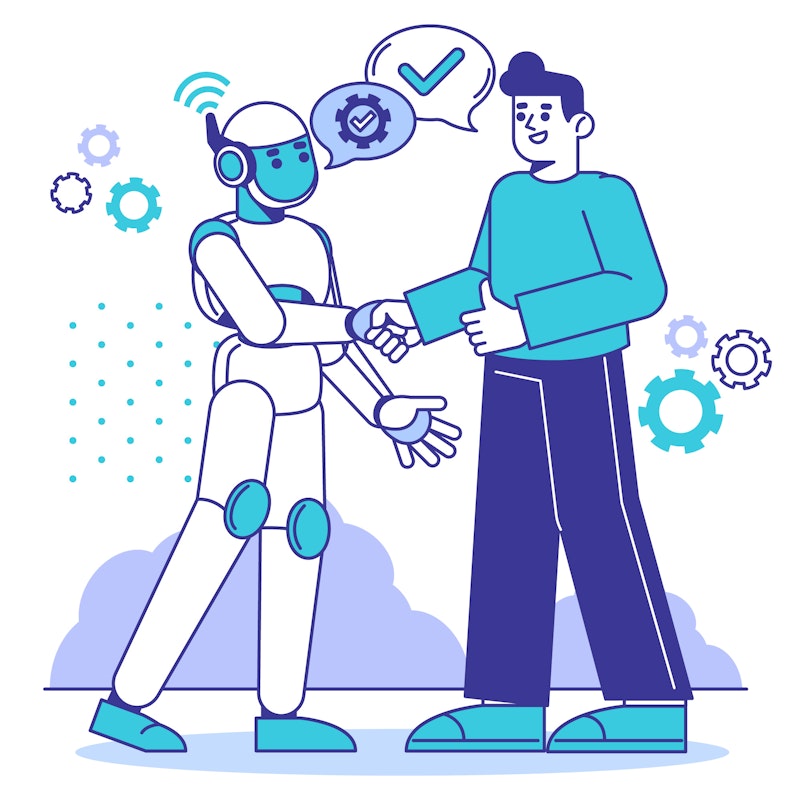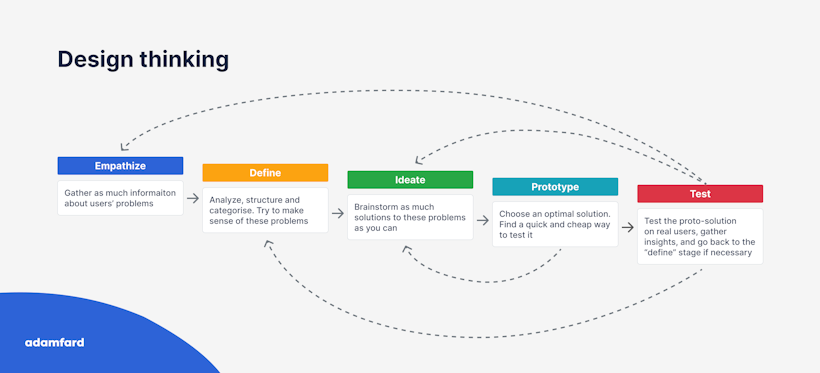Introduction
The convergence of artificial intelligence (AI) and design has ushered in a new era of product and service development. Beyond traditional human-centered design, we are now in the realm of human-AI-centered design. AI-powered experiences are characterized by personalization, adaptability, and intelligence, challenging designers to rethink their approaches and methodologies.
This shift necessitates a paradigm change. While human-centered design has been the cornerstone of successful products, it's now essential to integrate AI capabilities seamlessly into the design process. To create truly exceptional AI-powered experiences, designers must understand the nuances of human-AI interaction and develop new frameworks that balance human needs with AI potential. This article explores the fundamental principles and methodologies required to excel in the evolving landscape of AI UX design.
The effective design of AI-powered experiences demands a novel approach that harmonizes human needs, AI capabilities, and ethical considerations. Read on to learn more about this process.
Understanding the AI-Powered Experience
Traditionally, user experiences were static, relying on predefined interactions. Users navigated through predetermined paths, and the product or service offered limited adaptability. However, the advent of AI has fundamentally altered this approach.
Key Characteristics of AI-Powered Experiences
AI-powered experiences are distinguished by several key characteristics:
Personalization: Unlike traditional experiences that offer a one-size-fits-all approach, AI enables highly personalized interactions. By analyzing user data, AI systems can deliver tailored content, recommendations, and features.
Adaptability: AI-driven products can evolve over time, learning from user behavior and adapting to changing preferences. The dynamic nature of adaptive AI ensures that the experience remains relevant and engaging.
Intelligence: AI imbues products with cognitive abilities, allowing them to “understand” user intent, make decisions, and anticipate needs. This intelligence creates more natural and intuitive interactions.
Proactivity: Rather than passively waiting for user input, AI-powered experiences can proactively offer assistance or suggestions. This anticipatory nature enhances user satisfaction and efficiency.
The Role of User Experience (UX) in AI-Powered Products
UX remains paramount in AI-powered products. While AI handles complex computations, UX designers ensure these interactions align with human needs and expectations. The focus shifts from designing static interfaces to creating adaptive ecosystems that evolve with users.
UX designers must collaborate closely with AI developers to create seamless and intuitive experiences. By understanding AI capabilities and limitations, designers can optimize user interactions and maximize the value of AI integration.
Core Principles of AI-Powered Design
The process of designing for AI-powered experiences blends established UX design principles with an understanding of AI capabilities. Several core principles guide this process. Let's go over them below.
Human-Centered AI Design: Balancing User Needs with AI Capabilities

Image by freepik
Human-centered AI design prioritizes user needs while harnessing AI's potential. It involves understanding user behaviors, emotions, and goals to create experiences that are both effective and enjoyable.
Designers must consider how AI can augment human capabilities, rather than replace them. By aligning AI features with user expectations, designers can build trust and loyalty. Striking this balance requires a deep understanding of both human psychology and AI technology.
Ethical Considerations: Privacy, Bias, and Transparency
Ethical considerations are paramount in AI-powered design. Protecting user privacy is essential, requiring transparent data handling practices. Designers must actively identify and mitigate biases in AI algorithms to ensure fairness and inclusivity.
Transparency in AI decision-making builds trust and accountability. By adhering to ethical guidelines, designers can create AI-powered experiences that benefit users without compromising their rights or values.
Iterative Design Process for AI-Powered Products
Designing for AI requires a dynamic and iterative approach. Unlike traditional design, AI-powered products should evolve based on user interactions and data. Rapid prototyping, testing, and refinement are crucial. Design teams must be agile, adapting to AI's learning and growth. Also, collaboration between designers, data scientists, and users is essential for continuous improvement.
Why User Testing and Feedback Are Important
User testing remains a cornerstone of design, more so in the age of AI. Gathering feedback from real users is essential for identifying areas for improvement and ensuring that AI features align with user expectations. Iterative testing and refinement based on user insights are vital for the success of AI-powered products and experiences.
By adhering to these core principles, designers can create AI-powered experiences that are both user-centric and technologically advanced.
New Frameworks for AI-Powered Design
Traditional design methodologies are not sufficient for AI-powered experiences. New frameworks are emerging to address the unique challenges and opportunities presented by AI. They include:
#1. AI-First Design Thinking: Adapting Design Thinking for AI-Driven Products

Design thinking, a human-centered approach, needs adaptation for AI-powered products. AI-first design thinking involves understanding AI capabilities from the outset and integrating them into the design process. It emphasizes:
Identifying AI opportunities
Defining AI problems
Ideating AI solutions
Prototyping AI features
And testing AI experiences
#2. Human-AI Interaction Design: Designing for Seamless Collaboration

Effective human-AI interaction is essential for successful AI-powered experiences. This framework focuses on designing intuitive interfaces, clear communication, and appropriate feedback mechanisms. It involves understanding user expectations and behaviors when interacting with AI systems and ensuring a seamless transition between human and AI tasks.
#3. Balancing AI Capabilities and Constraints
Understanding AI's strengths and limitations is crucial. Design for AI focuses on optimizing AI algorithms, data quality, and system architecture. It involves creating design solutions that leverage AI's potential while mitigating its shortcomings. This approach requires close collaboration between designers and data scientists.
#4. AI-Driven Service Design: Creating Holistic Experiences
AI-powered experiences often involve multiple touchpoints and interactions. AI-driven service design focuses on creating holistic experiences across various channels and devices. It requires:
Mapping out the entire customer journey
Identifying opportunities for AI integration
And ensuring consistency in the user experience
These frameworks provide a foundation for designing effective AI-powered experiences. Designers can combine these approaches to create innovative and user-centric products. In the next section, we will consider the steps taken to implement them.
Methodologies for AI-Powered Design
Designing for AI-powered experiences requires a unique set of methodologies that depends on AI-specific approaches. By understanding and applying these methodologies, designers can create successful AI-powered products.
#1. User Research for AI-Powered Products
User research remains fundamental in AI-powered design. However, it requires a shift in focus to understand how users interact with AI systems. Researchers must delve into user expectations, attitudes towards AI, and the impact of AI on user experiences. Additionally, gathering data on how users interact with AI features is crucial for informing design decisions.
#2. AI-Assisted Prototyping and Testing
AI can accelerate the prototyping process by generating design variations based on user data and design constraints. Designers can use AI to create multiple prototypes quickly, enabling rapid testing and iteration. AI-powered tools can also analyze user feedback to identify areas for improvement, optimizing the design process.
#3. Measuring Success: Metrics for AI-Powered Experiences
Traditional design metrics may not suffice for AI-powered products. New metrics are needed to assess the performance of AI features and their impact on user satisfaction. Key performance indicators (KPIs) should focus on:
AI adoption
User engagement with AI features
The overall value derived from AI interactions
#4. Design for Scalability and Adaptability
AI-powered products must be designed for scalability to accommodate growing user bases and evolving AI capabilities. The design system should be flexible to accommodate new features and functionalities. Additionally, the product should be adaptable to changing user behaviors and market trends. By anticipating future needs, designers can create products that have a long lifespan.
These methodologies, when combined, provide a solid foundation for designing successful AI-powered experiences.
Case Studies: Successful AI-Powered Products
As an AI UX design agency, we are big on building AI-powered interfaces that meet user needs and expectations, both for clients and in-house.
#1. Th!nkpricing - A Pricing Analytics Platform
Th!nkpricing embodies the application of AI-driven design principles. The platform owes its success to our ability to balance complex AI algorithms with user-centric design.
By prioritizing transparency and educating users about AI-generated pricing data, we built trust and effectively managed their expectations. Below is a screenshot of the flows we created during the process. You can view the full case study here.
The platform's intuitive interface and our clear communication about how AI generates pricing suggestions—including its limitations—demonstrate a strong commitment to the user experience.
Furthermore, an AI-focused UX design process enables us to iteratively refine the app’s pricing model based on user feedback.
The result? Loyal users who trust and understand AI data and an increased marketing budget for the client.
Th!nkpricing highlights the potential of AI to drive innovation and business value when paired with effective design principles.
#2. UX Pilot: A Case Study in Human-AI Collaboration
UX Pilot is a good example of how to translate AI-powered design principles into a tangible product. Our tool centers on user experience while leveraging AI capabilities—the recipe for creating intuitive and effective AI-driven interactions.
UX Pilot's ability to generate design variations while providing designers with control illustrates the core tenets of human-AI collaboration.
Moreover, we prioritize user feedback and continue to refine the platform to meet the fast-paced AI landscape. This showcases the importance of a user-centered approach to AI-powered product development and continuous improvement.
AI can revolutionize the design process when paired with a deep understanding of user needs. Try UX Pilot for free.
Challenges and Opportunities in AI-powered Experiences Design
Designing AI-powered experiences presents unique challenges that require innovative solutions. And to realize the full potential of AI in product development, we must overcome these obstacles:
Data security and privacy
Addressing algorithmic bias
Managing user expectations
Designers must work closely with data scientists and ethicists to mitigate these risks. Additionally, balancing the need for personalization with user control is crucial.
Ethical Considerations and Regulatory Landscape
The ethical implications of AI can not be overlooked. Designers must adhere to privacy regulations, avoid perpetuating biases, and ensure transparency in AI decision-making. Navigating the evolving regulatory landscape is important for responsible AI development.
The Future of AI-Powered Design
The future of AI-powered design holds immense potential. Advancements in natural language processing, computer vision, and augmented reality will open new frontiers for innovation. Designers who can adapt to these changes will be at the forefront of the industry.
Goes without saying that collaboration between designers, AI experts, and other stakeholders will be crucial for shaping the future of AI-powered experiences.
Conclusion
Designing for AI-powered experiences requires a delicate balance of human-centered design principles and advanced technological capabilities. If designers develop a firm understanding of the potential of AI and its limitations, they can create products that not only meet user needs but also anticipate and exceed expectations.
The future of design is undeniably intertwined with AI. To thrive in this evolving landscape, designers, organizations, and educational institutions must prioritize ongoing learning and adaptation.
Leveraging AI design tools like UX Pilot is a good way to embrace new frameworks and methodologies. With such tools, we can harness the power of AI to create innovative and impactful experiences.
FAQs
What is the difference between traditional and AI-powered design?
Traditional design focuses on static experiences, while AI-powered design emphasizes personalization, adaptability, and intelligence. It involves creating dynamic interactions that evolve with users.
Why is user research important in AI-powered design?
User research is crucial for understanding how people interact with AI. It helps identify opportunities for improvement, ensures AI aligns with user needs and prevents biases from creeping into the design.
What are the ethical considerations in AI-powered design?
AI-powered design must prioritize user privacy, avoid bias, and be transparent. Designers must consider the potential impact of AI on society and ensure it benefits everyone equitably.





